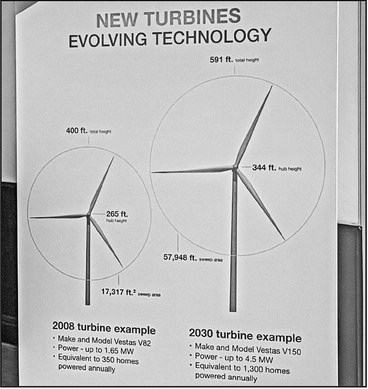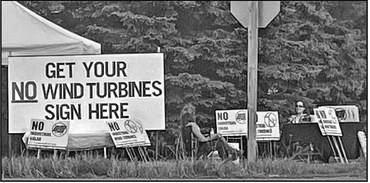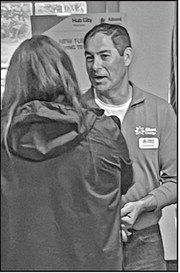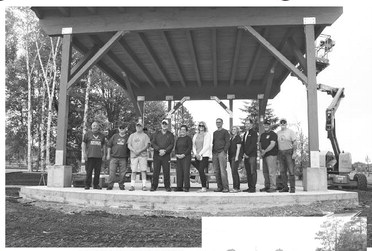Alliant Energy forges ahead with wind project


By Kevin O’Brien
Representatives from Alliant Energy hosted a three-hour open house last Thursday in the town of McMillan to speak with residents one-on-one about a proposed wind energy operation that promises to generate at least 100 megawatts of electric and provide a total of $500,000 per year in revenue for Marathon County and five rural townships.
“Hub City Wind Farm,” as the project was dubbed earlier this year, is slated to take shape over the next few years in the towns of Day, Cleveland, Green Valley, Eau Pleine and McMillan. Alliant has signed leases with multiple landowners in those townships in order to put wind turbines on their land, but the company still needs to sign up more land and go through a multi-year permitting process with the Wisconsin Public Service Commission (PSC).
The proposal has created a considerable amount of public backlash since it was first unveiled a couple of years ago, leading to some heated township meetings and a rash of licensing ordinances seeking to restrict largescale renewable operations, but last Thursday’s event at the Belvedere Supper Club was a decidedly cordial affair. Across the street from the event, however, members of Wisconsin Advocates For Responsible Energy (WARE) distributed yard signs expressing opposition to wind turbines.
Madison-based Alliant Energy plans to erect up to 25 wind turbines, each about 600 feet tall at the tip of the turbine blade, on land south of Stratford, from McMillan to Rozelville. Rural residents who have spoken at public meetings over the past few years have expressed concerns about the height of
See HUB CITY/ page 2 Hub City
Continued from page 1
the turbines, along with potential threats to public safety and wildlife, negative impacts on property values and damage to rural roads during construction.
Rick Zimmerman, project engineer for Alliant Energy, spoke to reporters at last week’s event, touting the benefits of the wind power system and addressing questions and concerns from area residents.
When asked about a recent Marathon County ruling upholding the legality of licensing ordinances in the towns of Eau Pleine and Brighton, Zimmerman said he was familiar with the case but had not had a chance to read Judge LaMont Jacobson’s decision. That lawsuit, filed by EDP Renewables, dealt with a neighboring project called Marathon Wind Farm centered around land in Eau Pleine and Brighton.
Zimmerman said Alliant Energy is prepared to work with local townships to get its project completed, but a key difference between Hub City Wind Farm and EDP’s Marathon Wind Farm is the size.
“In the state of Wisconsin, 100 megawatts is a key distinction of who gets the permitting authority,” he said. “They were under 100, so when you’re under 100, the local community… they have the permitting jurisdiction. That’s why they encountered the more restrictive ordinances that were recently passed.”
Alliant Energy’s goal is to generate at least 100 megawatts with Hub City Wind Farm, with the possibility of going as high as 120 MW if enough landowners sign up, he said. Once they reach that 100 MW threshold, he said the PSC will have licensing authority over the project.
“We’re not there yet,” he said. “We still have a ways to go as far as landowner control in order to start siting turbines, etc, but we believe we’ve got some momentum. We’re probably a little more than halfway there on that, and hopefully events like this encourage some additional enthusiasm.”
Last Thursday’s open house featured multiple poster boards with information about Hub City Wind Farm, including a project timeline, regulatory requirements and technical information about the turbines. Several Alliant Energy employees, including some wearing “Hub City Wind Farm” t-shirts, spoke to attendees, who were offered a food buffet and items such as pens and screwdrivers bearing the project name.
The state permitting process requires companies like Alliant Energy to obtain what’s called a Certificate of Public Convenience and Necessity (CPCN) from the PSC, but prior to filing that application, it must first submit a preliminary engineering plan to the Wisconsin DNR. The process also includes a mandatory environmental assessment with a 10-day comment period, and additional technical and public hearings.
If Hub City Wind Farm were to be established, Zimmerman said one of the greatest benefits to the area is the shared revenue payments collected by the state and distributed to the county and municipalities where the wind turbines are located. The annual shared revenue payment is $5,000 per megawatt, and if Hub City generates 100 megawatts, that would equate to $15 million over the 30year lifespan of the project, according to information from Alliant.
That money – about $283,000 per year for Marathon County and $217,000 for the five townships – does not have any strings attached, he noted, meaning that local officials can decide how they want to spend it. This money is in addition to the payments made to private landowners who have signed leases with Alliant that will allow the utility to put in access roads and erect wind turbines or build substations on their properties.
Zimmerman said adding more wind energy to Alliant’s power grid will also help ratepayers over time, calling wind “one of the more affordable generation resources that we have.”
“We’re doing this to keep our rates as low as they can be,” he said. “This probably will not reduce the rates we have, as far as what customers pay, but it helps delay and lowers the increases we have.”
Zimmerman said most of the electricity generated by Hub City Wind Farm will stay in Wisconsin, though some of it could go to other states if the supply exceeds local demand. Primarily, though, he said the project is meant to meet the increasing demands of customers, including massive data centers coming into the state, and not to sell the electricity to neighboring states.
At the same time, Zimmerman said Alliant is keeping an eye on what is happening in Washington, D.C., and how President Trump’s “Big Beautiful Bill” might impact renewable energy tax credits offered through the Infrastructure Reduction Act passed during the Biden administration.
Alliant’s goal is to start construction on the project by 2029 after applying for a CPCN from the PSC in 2027, but that could change if federal law changes before a permit is approved.
“We’ll be close if we can get it done in 2028,” he said. “If we can’t, maybe the project doesn’t advance for that reason.”
Based on the number of landowners currently signed up, Zimmerman said the potential scope of the project is not where Alliant wants it to be, and because of an environmental corridor on the east side of the project area and EDP’s project to the west, he said the number of potential participating landowners is somewhat limited.
“So, we’ve only got a certain number of landowners we can actually go to and address and see if they’re interested,” he said. “If we’re less then 100, than we have to go back to the local permits.”
TALLER TURBINES, MORE POWER - One of the poster boards put up by Alliant Energy at last week’s open house on the Hub City Wind Farm shows the increase in height and power capacity of wind turbines from 2008 to what is expected by 2030.` STAFF PHOTOS/KEVIN O’BRIEN
LOCAL OPPOSITION - Members of Wisconsin Advocates of Responsible Energy (WARE) distributed yard signs across the street from Alliant Energy’s open house, expressing opposition to wind turbines.
TIME TO TALK - Rick Zimmerman, resource development manager for Alliant Energy, speaks to a reporter from WSAW about the company’s proposed Hub City Wind Farm project in southwestern Marathon County.






